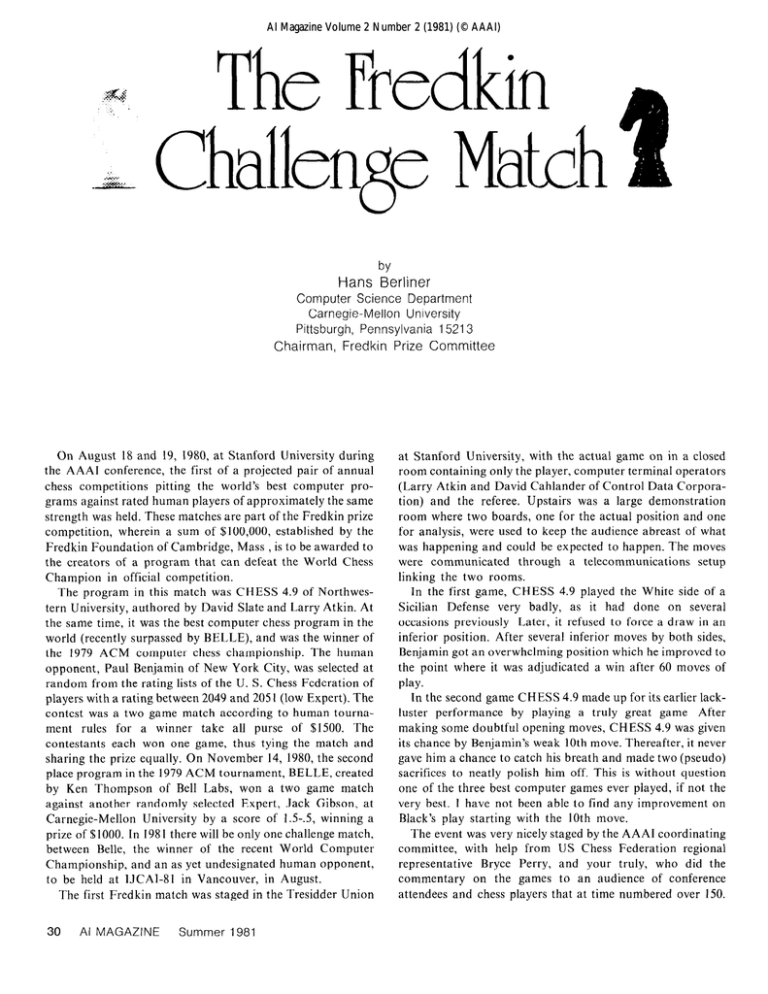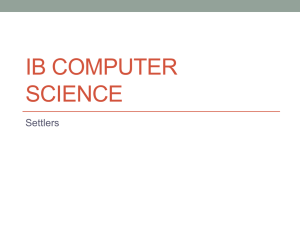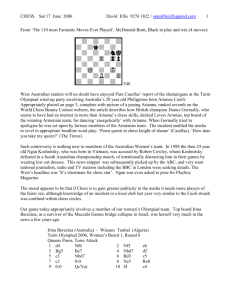The AI!+halhge Fredkin .'*A.
advertisement

AI Magazine Volume 2 Number 2 (1981) (© AAAI) TheFredkin ..'*A. . AI!+halhge M&h by Hans Berliner Computer Science Department Carnegie-Mellon University Pittsburgh, Pennsylvania 15213 Chairman, Fredkin Prize Committee On August 18 and 19, 1980, at Stanford University during the AAAI conference, the first of a projected pair of annual chess competitions pitting the world’s best computer programs against rated human players of approximately the same strength was held. These matches are part of the Fredkin prize competition, wherein a sum of $100,000, established by the Fredkin Foundation of Cambridge, Mass , is to be awarded to the creators of a program that can defeat the World Chess Champion in official competition. The program in this match was CHESS 4.9 of Northwestern University, authored by David Slate and Larry Atkin. At the same time, it was the best computer chess program in the world (recently surpassed by BELLE), and was the winner of the 1979 ACM computer chess championship. The human opponent, Paul Benjamin of New York City, was selected at random from the rating lists of the U. S. Chess Federation of players with a rating between 2049 and 205 1 (low Expert). The contest was a two game match according to human tournament rules for a winner take all purse of $1500. The contestants each won one game, thus tying the match and sharing the prize equally. On November 14, 1980, the second place program in the 1979 ACM tournament, BELLE, created by Ken Thompson of Bell Labs, won a two game match against another randomly selected Expert, Jack Gibson, at Carnegie-Mellon University by a score of 1.5-.5, winning a prize of $1000. In 198 I there will be only one challenge match, between Belle, the winner of the recent World Computer Championship, and an as yet undesignated human opponent, to be held at IJCAI-81 in Vancouver, in August. The first Fredkin match was staged in the Tresidder Union 30 Al MAGAZINE Summer 1981 at Stanford University, with the actual game on in a closed room containing only the player, computer terminal operators (Larry Atkin and David Cahlander of Control Data Corporation) and the referee. Upstairs was a large demonstration room where two boards, one for the actual position and one for analysis, were used to keep the audience abreast of what was happening and could be expected to happen. The moves were communicated through a telecommunications setup linking the two rooms. In the first game, CHESS 4.9 played the White side of a Sicilian Defense very badly, as it had done on several occasions previously Later, it refused to force a draw in an inferior position. After several inferior moves by both sides, Benjamin got an overwhelming position which he improved to the point where it was adjudicated a win after 60 moves of play. In the second game CHESS 4.9 made up for its earlier lackluster performance by playing a truly great game After making some doubtful opening moves, CHESS 4.9 was given its chance by Benjamin’s weak 10th move. Thereafter, it never gave him a chance to catch his breath and made two (pseudo) sacrifices to neatly polish him off. This is without question one of the three best computer games ever played, if not the very best. I have not been able to find any improvement on Black’s play starting with the 10th move. The event was very nicely staged by the AAAI coordinating committee, with help from US Chess Federation regional representative Bryce Perry, and your truly, who did the commentary on the games to an audience of conference attendees and chess players that at time numbered over 150. Game 1 Fredkin Challenge Match I Sicilian Defense WHITE CHESS 4.9 BLACK Benjamin 1. P-K4 2 N-KB3 3. P-Q4 4. NxP 5. N-QB3 6. B-K2 7 o-o 8 B-KN5 (A) 9. NxN? (B) 10. Q-Q2 Il. QR-NI 12. P-QN4!? (D) 13. B-KR6 14 P-KR3? (E) 15. PxP ? (F) 16. NxN 17. QxQ 18. B-KB4 19. B-QN5 20. B-Q3 21. B-QR6! 22 B-QN5 23. B-Q3?? (HI 24. B-K3?? 25. B-KB4 26. BxB?? (J) 27 P-R3 28. B-R6 29 P-N5 30 R-N3 31. R-Q1 32 KR-Nl 33. P-N3 (K) 34. K-N2. 35. B-B1 36. R-KB3 37. R-N2 38. R-N3 39. R-N2 40. R-N3 41 R-N2 42. R-B4 43. PXP! 44. PXP 45. P-QR4 46. PxPch 47 R-B4 48 R-K2ch 49. R/B-K4 P-QB4 P-Q3 PXP N-KB3 P-KN3 B-N2 o-o N-B3 PxN R-N1 R-K1 CC> B-K3 B-RI P-Q4 NxP! QxN! PxQ QR-Bl KR-Ql B-B6?? (G) R-B3 QR-B 1 B-Q2?? (I) P-Q5 B-B4! PxB P-B3 R-B3 R-N3 R-QBl R-B4 R-B5 P-K4 K-B2 B-R4 K-K3 B-B6 (L) B-R4 B-B6 B-R4 P-K5? (MI P-Q6! RxB R-B4! (N) R-N2 RxP R-Q4 K-Q2 K-B1 50. R-K8ch 51. R/8-K4 52. R-K6 53. R-K7 54. R-K8ch 55. P-N4 56. R/2-K4 57. RxR 58. K-B3 59. R-B8 60. P-R4 Adjudicated R-Q1 R/ 2-Q2 R-03 R/l-Q2 B-Q1 K-N2 R-Q5 RxR R-Q3 R-Q2 K-N3 win for Black (P) Game 2 Fredkin Challenge Match I Pirc Defense Reversed WHITE Benjamin BLACK CHESS 4.9 1. N-KB3 2. P-KN3 3 P-Q3 4. QN-Q2 5. B-N2 6. O-O 7. P-K4 8. P- B3 9. P-KR3 10. P-QN4? (RI 11 PXP 12. B-N2 13. NxN 14. N-Q4 6) 15. NxN 16. R-K1 (T) 17. BxP (U) 18. Q-R4 19. R-K2 20. R-B2 (VI 21. R-Q2? (WI 22. RxR (XI 23. RxRch 24 BxB 25. PxP 26. R-Q1 27. R-Q2 28. BxB 29. B-N5 30 B-B1 31. P;QR4 32. P-R5 33. R-R2 34. P-R6 (BB) 35. P-R7 Resigns (CC) P-Q4 N-QB3 P-K4 N-B3 B-K2 o-o Al MAGAZINE K-RI (Q> B-KN5 B-K3 PXP! Q-Q6 NxKP! QxN/S Q-N3 PxN P-QR4! QR-Q1 Q-B3! B-B5! B-Q6! B-N4!! BxQ BxR PXP BxP B-B4 B-Q5 PxB Q-K4! (Y> P-KN3 (Z) P-QB4 Q-K8! (AA) P-Q6! P-Q7 QxBch! Summer 1981 31 Annotations. (A) This is not the right way to proceed. The bishop is better protecting the center, so 8. B-K3 is indicated. (B) And this is definitely bad. CHESS x x has consistently played this move in positions of this type on the premise that isolating Black’s QRP is bad This is largely illusory, while strengthening Black’s center and opening the QN-file are to be avoided. 9. N-N3 is best. (C) This is an unneccesary waste of time. The “threat” of B-KR6 is not a threat as the exchange of bishops leaves White with the worse bishop. B-K3 or N-Q2 is correct. (D) This enterprising move sets the tone for a lot of what is to follow White gains space on the Q-side, but weakens his QBP which now becomes backward. White should now strive to increase his control of space, but his play reveals that he does not understand this (E) An awful move that allows Black a number of It was correct to play P-B4, favorable responses. threatening P-R5 with a significant attack. (F) After this White’s position is just about lost He had to try 15 P-K5, N-K.5, 16. Q-Q4 with chances for both sides. Now he is forced into a hopeless endgame. (G) The correct way to proceed here is simply B-B4 followed by R-B6 and doubling rooks on the QR-file, which puts intolerable pressure on White. Instead the text allows White to force a draw! (H) Here White can (and should) force a draw with B-QR6 since R-RI, B-N7 loses the exchange, as well as 23.-- R-B3, 24. R-QNS, R-N3??, 25. B-B7!. The interesting fact about all this is that CHESS 4.9 had been set to only accept a draw (by forced repetition) if it was a pawn or more behind, a rather cavalier decision against White should be delighted to this caliber of opponent draw here (I) Black thinks he now avoids the draw, but instead gets himself into more trouble. Again B-B4 was correct. Now White can get a very good position with 24. B-QR6, R-R3, 25. B-N7!, R-B5, 26. B-N5!!, R-Kl!, 27 BxQP, RxP, 28. R-N3, but all this is too deep for both opponents. (J) This is the final straw, and seems to be related to the nature of the error on move 9. White again “isolates” a pawn (the KRP) only to ignore the major problem, the protection of his weak and backward QBP White should play P-N4 whereupon Black cannot afford to capture BxB as that would dissoli/e most of his advantage Black would 32 Al MAGAZINE Summer 1981 then still have major problems to solve because of his badly placed dark squared bishop, and it is not clear if he can force a win (K) White should march his king over to Ql to defend the backward pawn, but it is only a matter of time anyway. (L) Here and on many subsequent moves Black can win easily by merely playing R-N1 followed by R/l-QBl winning the QBP. He apparently never sees this plan which could have saved him lots of headaches. (M) time time to a Black has been moving back and forth to reach the control on the 40th move, and now with plenty of to consider, makes a break that does lead tortuously win (N) It is very important to play this move as after the inferior 44.-- PxP, 45. RxPch, K-any, 46. R-QR4 White wins another pawn and that is too much. The rest is slow but rather straightforward. (P) The game had to be adjudicated as the second game was scheduled for August 19, and there was not computer time to be able to play any further. Black wins rather easily by moving the king in to capture both of White’s Q-side pawns and the advancing his QRP There is little White can do to counter this, and his advance on the other side can be effectively delayed by Black’s extra bishop (Q) Benjamin is trying to play a closed positional game in which computers have greater difficulty than in open positions, and he appears to be succeeding. The text move is a waste of time, Black should be developing his QB to an effective square. (R) At this point it appears that White has a clear edge. 10 N-N5 forcing B-Bl, looks good but the thematic continuation 11 Q-N3, N-QR4, 12. Q-R4, P-B4, 13. PxP, NxP, 14 NxRP, KxN, 15 Q-K4ch, K-Nl, 16. QxN, QxQ, 17. BxQ, BxP leaves Black with a good game Probably, simply 11. R-K1 is best White’s text, however, is very bad, allowing Black to open up an immediate attack in the center. (S) This is the natural move in situations of this type, but possibly White would be better advised to play 14 R-Kl, Q-B4, 15. P-N.5, N-R4, 16. NxP, QR-Ql, 17. Q-R4 although Black’s chances seems somewhat better than White’s. (T) White does not want to play 16. RxP because after QR-Ql, 17. Q-R4, BxRP Black remains a pawn ahead. Now, however, Black takes charge. His next move (P-QR4) is a th ing of beauty, getting rid of a weak pawn and forcing the issue on the Q-side, whereas the more obvious QR-Ql, 17 Q-K2 leaves Black with a less dynamic position. (U) It would have been better to play 17. RxP, PxP, 18. PxP, BxNP, when Black has clearly the better of it, but White does not appreciate that he is getting in deeper and deeper. (V) White probably counted on only 18.-- BxRP, 19. RxP when he should be able to defend himself. The text threatens R-Q7 with the double threat of RxB and QxPch with mate next move. To defend against this by 19. QR-Ql is not pleasant as BxRP threatens B-KN.5 which would force White to give up control of the Q-file and permit new intrusions into the White position. (W) Again White had probably counted on 19 -- BxRP when 20 P-QB4, BxP, 21. BxP gives White chances. Black’s actual move is his best of the game B-B5 is positionally desirable as the B exercises more control from this point than anywhere else on the board, and thus cramps White’s whole position However, to forego winning a pawn by BxRP is something that a program is unlikely to do unless it can see more elsewhere. This was, in fact, the case (see next note). (W) Commenting on the game in front of the audience, I suddenly realized that Black would never have allowed this position when it could have won a P by 19 -- BxRP There had to be a reason why White could not get away with this Armed with this information, it was easy to point out that now Black’s next move CR-N4) was coming and wins everything. iater we learned that CHESS 4.9 thought the main line was 21. R/2-Bl, P-K5 when it thought it considered itself to be .7 pawns ahead. Agreed; except that the positional advantage is much greater since White cannot rally his pieces to the defense of the king, which is sitting there waiting to attacked by moves such as Q-R3, followed by P-KB4-B5 It would be too much to ask 4.9 to understand all that, its judgment was fine indeed (X) Qtor B)xB is insufficient as RxR threatens another piece and also mate. Black now makes short shrift of White. (Y) White is trying to set up a defense against the advancing Q-side pawns along the diagonal QR6-KBl. However, this move which threatens the B and also Q-K8ch winning the rook, forces the White pieces into cramped positions where they cannot achieve this goal (Z) This is directed against possible back rank mates. Note that 4.9 correctly moves the pawn that frees a square that cannot be covered by the opposing B (I am not sure if it did this by accident or not). (AA) The final combination begins. Very pretty. We had it all figured out in the demonstration room and wondered if 4.9 would be able to see the whole thing. Apparently it did. White’s moves are all forced now. (RR) At this point, the communication operator to the closed room where the game was being played, told the audience that Benjamin had just said that “he had never played a game with 3 queens before” (apparently believing that 34.-- P-Q7, 35. P-R7, P-Q8(Q), 36. P-R8tQ)ch was going to happen. I commented that “he wasn’t going to have that experience tonight either” (CC> Now he sees what CHESS 4.9 saw at move 33: 36. KxQ, P-Q8(Q)ch, 37. K-N2, Q-Q4ch wins the rook and also prevents the pawn from queening. n The Knowledge Level (continuerifkm page 20) References (continued) Schank, R & Ableson, R Scripts, Understanding. Hillsdale, NJ: Lawrence Plans, Goals ad Erlbaum 1977. Shortliffe, E H. Computer-based Medical Consultatims. MYCIN New York: American Elsevier 1976 Simon, Millan H A. Administrative 1947 Behavior. New York: Mac- Simon, H A. Cognitive science The newest of the artificial sciences Cogniti\le Science, 1980, 4, 33-46. Stockton, F R The Lady or the Tiger? In A Chosen Felt,, Short storier, New York: Charles Scribner’s Sons, 1895 von Neumann, J & Morgenstern, 0 The theor 1’ of Gurney or7d Economic Behavior Princeton, NJ: Princeton University Press 1947. Advertise in Al Magazine Present your message to a highly qualified audience of Computer Science professionals, For a media kit, write to. Al Magazine P. 0. Box 801 La Canada, Calif. attn: Advertising Al MAGAZINE 91011 Summer 1981 33




